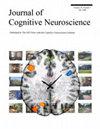脑电图探照灯解码揭示了特定人和特定地点对语义类别和熟悉程度的反应。
IF 3.1
3区 医学
Q2 NEUROSCIENCES
引用次数: 0
摘要
专名是指独特实体的语言表达,如个别的人或地方。这使它们有别于普通名词等指代一般概念的词语。然而,尽管都是个体实体,一个人最亲密的朋友和一个人最喜欢的城市在直觉上却与截然不同的知识片段联系在一起,前者包括面孔、声音、社会关系和自传经历,后者则主要是视觉和空间信息。神经影像学研究表明,在对单个实体进行语义处理时,大脑既存在领域一般的相关性,也存在领域特定的相关性;然而,这种共性和相似性如何在细粒度的时间尺度上发挥作用,目前仍不清楚。在这项研究中,我们利用脑电图和多变量(时间分辨和探照灯)解码分析来解决这个问题。我们研究了何时何地我们可以准确解码专有名词的语义类别,以及我们是否可以发现熟悉度对特定人或特定地点的影响,熟悉度是一个与模式无关的维度,因此可以避免两个类别之间固有的感觉运动差异。语义类别可以在时间窗口内解码,并具有通常与词汇语义处理相关的空间定位功能。关于熟悉程度,我们的研究结果表明,在早期和晚期的时间窗口中,与地点相比,我们更容易区分与人的熟悉程度相关的诱发活动模式。其次,我们发现在早期反应中,可以区分出领域一般(左后外侧)和领域特定(右前颞,仅针对人)的神经模式,这表明存在针对人的特定过程。本文章由计算机程序翻译,如有差异,请以英文原文为准。
Electroencephalography Searchlight Decoding Reveals Person- and Place-specific Responses for Semantic Category and Familiarity
Proper names are linguistic expressions referring to unique entities, such as individual people or places. This sets them apart from other words like common nouns, which refer to generic concepts. And yet, despite both being individual entities, one's closest friend and one's favorite city are intuitively associated with very different pieces of knowledge—face, voice, social relationship, autobiographical experiences for the former, and mostly visual and spatial information for the latter. Neuroimaging research has revealed the existence of both domain-general and domain-specific brain correlates of semantic processing of individual entities; however, it remains unclear how such commonalities and similarities operate over a fine-grained temporal scale. In this work, we tackle this question using EEG and multivariate (time-resolved and searchlight) decoding analyses. We look at when and where we can accurately decode the semantic category of a proper name and whether we can find person- or place-specific effects of familiarity, which is a modality-independent dimension and therefore avoids sensorimotor differences inherent among the two categories. Semantic category can be decoded in a time window and with spatial localization typically associated with lexical semantic processing. Regarding familiarity, our results reveal that it is easier to distinguish patterns of familiarity-related evoked activity for people, as opposed to places, in both early and late time windows. Second, we discover that within the early responses, both domain-general (left posterior-lateral) and domain-specific (right fronto-temporal, only for people) neural patterns can be individuated, suggesting the existence of person-specific processes.
求助全文
通过发布文献求助,成功后即可免费获取论文全文。
去求助
来源期刊
CiteScore
5.30
自引率
3.10%
发文量
151
审稿时长
3-8 weeks
期刊介绍:
Journal of Cognitive Neuroscience investigates brain–behavior interaction and promotes lively interchange among the mind sciences.

 求助内容:
求助内容: 应助结果提醒方式:
应助结果提醒方式:


